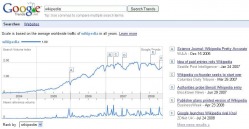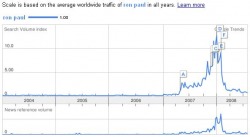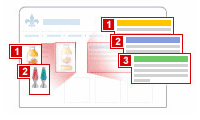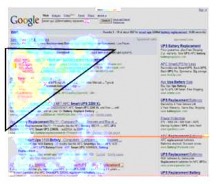How is it possible to tell what the population is thinking at a given point in time? By using a free service called Google Trends. Trends measures how often people search for a given word or phrase.

Here is a graph of the searches for "Wikipedia". Interest rose gradually until summer 2005 when growth started accelerating. The site achieved preeminence in 2007 and 2008. Searches drop off during the holidays, suggesting that Wikipedia tends to be used during work.

Here are the queries for "Ron Paul". The drop in searches after the primary show that he may be having difficulty converting his campaign inertia to long term momentum.
Google Trends delivers what was nearly impossible almost five years ago, a precise time line of the interests of people all over the world.
Eight weeks.
That was how long it took for my computer to fail. I was knee deep in a new version of my business plan and now all I could do was watch my PC as it restarted itself over and over. Not only was my computer broken, but I could no longer access my work. If I reformatted, all of my data would be lost. Three weeks worth of research was now stuck in some algorithmic black hole, I could only hope that it wasn't lost forever. The only solution was to cross my fingers, pay 35 bucks and take it to a computer repair store.
Four days later I had a broken computer, and a burned CD with my multi-million dollar business plan on it, hanging on for dear life.
Almost 100% of patients who successfully beat cancer report the experience as having a positive impact on their life. Though not as serious, nearly losing all of my work got me seriously thinking about improving my relationship with my computer. Looking for a solution, I started thinking about computer terminals at the library, or at school. Every time someone sits down, the computer is as good as new. It restores itself to normal and runs quickly, like the first day it was used. If library users could enjoy this "New Computer Smell" year round, why couldn't I?
After asking around for a few days, I discovered a program called Deep Freeze. The program works by restoring windows to the same state, every time it is restarted. Like getting to use a brand new computer every day. I also discovered that by creating a "partition" on your hard drive, you can virtually create two separate hard drives. By "Freezing" the one that windows is on and keeping the other one "Thawed", you can now save your data while making sure that windows works as well as it did the first day you bought it.
I reformatted (or erased) my hard drive, reinstalled windows, and installed deep freeze. That was more than a year ago. Since that day I have never had a single computer problem.
How to get rid of viruses forever
1. Save your important data (a burn CD or USB drive will do)
2. Stick in your Windows CD and start a normal reinstall.
3. Setup will ask you where you want to install, it will give you the option to create a partition. It looks like this. Create a smaller partition and install windows on it. (20 GB) Format the remaining space as the D: drive.
4. After installing, configure windows how you like it and move My Documents to your second hard drive.
5. Download and install Deep Freeze. (A free trial can be downloaded here) Set it to freeze your C: drive, keep your D: drive thawed.
To install a new program, simply use deep freeze to "thaw" your computer, Make your changes, and then restart back into a frozen state.
Your computer is now bulletproof. You can open your Windows folder and delete system files, change all of your settings, or download viruses; once you hit restart your system it will operate as well as it did the day you bought it.
Have you ever wondered how high budget websites achieve their pleasing layouts? They use something called Multivariate Testing to scientifically test different versions of the website. This determines which test website creates the most conversions (sales) or retains visitors the longest.

Multivariate Testing: A process by which more than one component of a website may be tested in a live environment. It can be thought of in simple terms as numerous split tests or A/B tests performed on one page at the same time.
So how does it work?
Step 1: The marketer determines how detailed he wants the test to be. Depending on how much time or traffic is available, the marketer will choose many or few variables. MVT (Multivariate Testing) experiments can be mapped with an array.

This experiment has three test elements with two different variables of each.
Step 2: Element Selection - Once you have determined how detailed you want your test to be; you must now select which parts of the site to test. These include: Headlines, Navigation, Offers, Text Format, Price, and Buttons.
Step 3: Element Variation - After choosing what elements to modify, the next step is to decide what modifications to make. This is the most creative process of MVT. How should you address your audience; should you be emotional? stern? helpful? should you sound like an expert? How should you site look? should you give the user many choices, or few? should your site have moving parts? Should you erase those buttons or keep them?

It is helpful to know that viewers tend to look at the top left of a screen and move from there. Here is a heat map of the Google search page. Red marks where viewers tend to look the most.
MVT Software: Includes SiteSpect, Omniture, and many others. As MVT can be a tremendously profitable activity, software has been historically expensive. In 2007 Google released their free website optimizer.
Multivariate testing allows great marketers to become exemplary.





 RSS Feed
RSS Feed